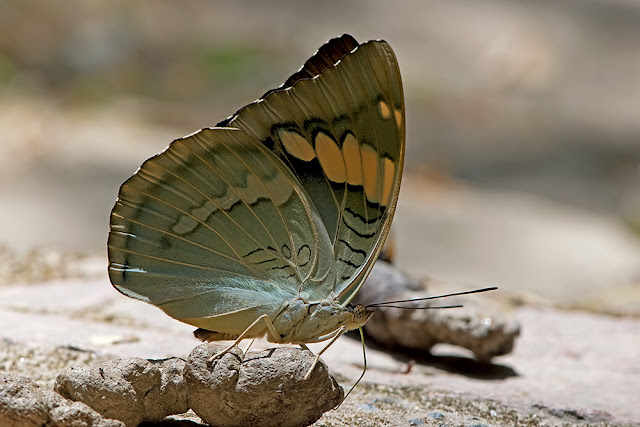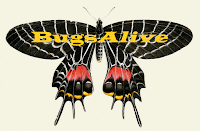Puddling behaviour in tropical butterflies
Written and photographed by Tim Stratford
Introduction
The term 'puddling' is used to describe the behaviour of insects, in particular tropical butterflies, that settle on various substrates to imbibe liquids and minerals using their proboscis as a kind of drinking straw. When observing puddling behaviour you could be forgiven for thinking that the butterflies are just having a drink but it is far more complex than that. Research shows that this behaviour is probably a form of supplementary feeding targeted towards specific micronutrients rather than as a means of obtaining energy. As butterflies are holometabolous (complete metamorphosis) with distinct developmental stages as egg, larva, pupa, and adult, their reproductive output is dependent on the combined effect of larvae-derived and adult-derived nutrients. Of course, adult butterflies are mainly nectar feeders but they can have quite diverse food habits in tropical regions, although much less so in temperate zones. Although this article is specifically aimed at Lepidoptera (butterflies and moths) there is a wide range of herbivorous and detritivorous terrestrial arthropods that have also been observed to puddle. These include insects from the Hymenoptera, Diptera, Orthoptera, Hemiptera, Blattodea, and Diplopoda groups. As the concept of puddling relates to supplementary feeding, those insects that feed exclusively on dung or carrion, for example dung beetles, are not considered as 'puddlers'.
The term 'puddling' is used to describe the behaviour of insects, in particular tropical butterflies, that settle on various substrates to imbibe liquids and minerals using their proboscis as a kind of drinking straw. When observing puddling behaviour you could be forgiven for thinking that the butterflies are just having a drink but it is far more complex than that. Research shows that this behaviour is probably a form of supplementary feeding targeted towards specific micronutrients rather than as a means of obtaining energy. As butterflies are holometabolous (complete metamorphosis) with distinct developmental stages as egg, larva, pupa, and adult, their reproductive output is dependent on the combined effect of larvae-derived and adult-derived nutrients. Of course, adult butterflies are mainly nectar feeders but they can have quite diverse food habits in tropical regions, although much less so in temperate zones. Although this article is specifically aimed at Lepidoptera (butterflies and moths) there is a wide range of herbivorous and detritivorous terrestrial arthropods that have also been observed to puddle. These include insects from the Hymenoptera, Diptera, Orthoptera, Hemiptera, Blattodea, and Diplopoda groups. As the concept of puddling relates to supplementary feeding, those insects that feed exclusively on dung or carrion, for example dung beetles, are not considered as 'puddlers'.
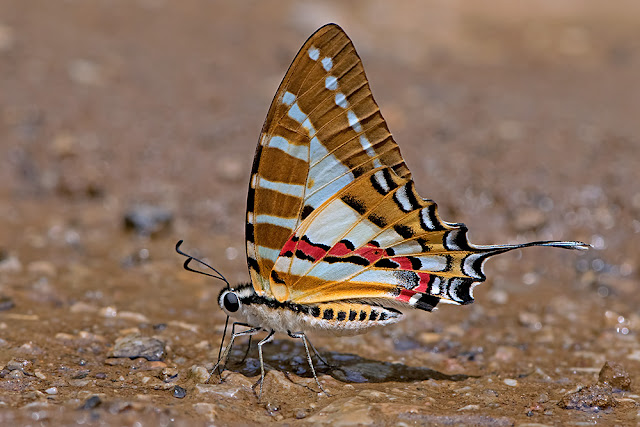 |
| Graphium nomius, the Spot Swordtail, puddling on mud substrate. I have not personally observed butterflies from the Papilionidae family puddle on anything other than mud or sand. |
Substrate Selection and Nutrition
The substrate on which butterflies settle may be anything from mud to animal dung or rotting fruit but by far the most common substrate used is moist sand or mud (hence the term 'mud-puddling'). However, there are many species that also feed on animal dung, bird droppings, urine, rotting fruit, carrion, and tree or plant sap. Some butterflies will even land on human skin or clothing to 'puddle' on sweat. Unlike their larvae which have specific food requirements, adult butterflies are opportunistic feeders and in addition to the nectar obtained from flowers, are capable of obtaining nutrients from a variety of sources. The amount of minerals acquired during the herbivorous larval stage is quite limited and behavioural traits such as puddling may enable the adult butterfly to obtain a balanced mineral intake and overcome the shortfall in larval nutrition.
One of the main minerals obtained through puddling is sodium, which has been suggested is important for neuromuscular function and also plays a major role in the successful reproductive behaviour of many butterflies. Most puddling butterflies are actually males, although this is not exclusive and in some particular species females are also known to puddle. As far as the males are concerned, what is thought to be happening is that they are absorbing minerals and other nutrients which they then pass on to females during mating via the spermatophore, a protein capsule containing the spermatozoa.
In essence, what puddling butterflies are doing is making up for the nutrients that they lack due to deficiencies in their diet both as adults and as larvae. These nutrients are scarce in nectar and puddling is a way of obtaining the minerals and nutrients that they need before they start mating. Males need to build up their stock of sodium (salts) and nitrogen (to form proteins) to enable them to transfer substantial amounts of sodium and protein to the females in the spermatophore. Females can lose a huge amount of their body salt as a result of egg laying and so this so-called 'nuptial gift' provided by the male is essential . It has been estimated that the amount of salt lost by the female as a result of egg laying can be as much as 75%. The quality of the nutrients in the spermatophore which the male provides not only improves the females fertility but probably also her own fitness and well-being.
Butterfly species vary in the particular substrates that they puddle on and there is a wide variation in soluble sodium content, with mud having the lowest concentrations and carnivore dung having the highest. A large percentage of puddling butterflies seem to prefer moist sand or mud but others are more specialised and prefer other sources such as mammal dung, bird droppings, carrion, rotting fruit and even tree or plant sap. Many of these 'specialists' also puddle on sand and mud as well. The acquisition of nitrogenous compounds such as amino acids and albumin from these other sources may be a good way of obtaining proteins as well as salts. Both dung and carrion are good sources of nitrogen as well as sodium. Butterflies appear to locate these food sources using both smell and visual signs. According to some researchers members of the Papilionidae and Pieridae families depend mainly on vision to discover food sources while Nymphalidae, Lycaenidae, and Hesperiidae butterflies rely on smell.
Where puddling occurs in females it may be that they are simply thirsty or it may be that they are trying to 'top up' their mineral and nutrient levels depleted during egg laying. Females only mate once but may have to replenish sodium reserves as they age. Males on the other hand can mate several times and may need to replenish reserves after each coupling. Older individuals of both sexes show similar puddling frequency and this suggests a similar need for sodium, although the causes may be different in each sex.
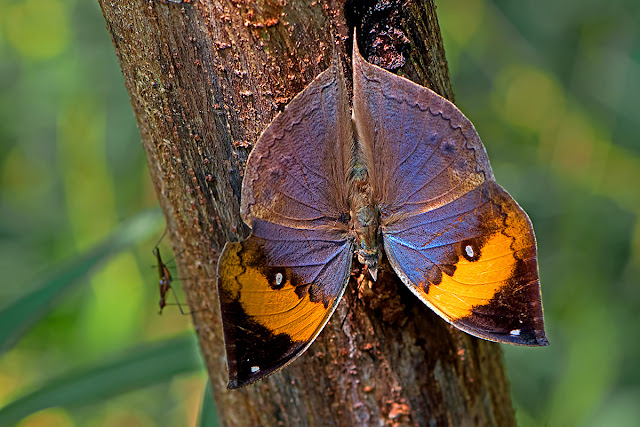 |
| Kallima inachus in typical upside down posture imbibing the sap from a tree. Normally it would have its wings closed making it almost undetectable to predators. |
Summary
Acquiring sufficient quantities of sodium and nitrogen is a pivotal issue for herbivores, particularly Lepidopterans, as the quality of their diet differs greatly during their life stages. The fact that puddling behaviour is more common in tropical environments is probably significant. Fluid-feeding insects, such as butterflies and moths, are faced with perhaps the only available option of having to remove and feed on trace amounts of fluids from porous surfaces. Insects that are able to acquire fluids that are confined within porous substrates during drought conditions would have an advantage and increased fitness over other species.
However, it is still poorly understood how adult butterflies extract nitrogen from different environments and much more research is required. The effects of sodium on neuromuscular activity in males during mating activities is also little known and theories have yet to be proven. Information suggests that the acquisition of sodium is the main element in puddling by butterflies but again more investigation is needed.
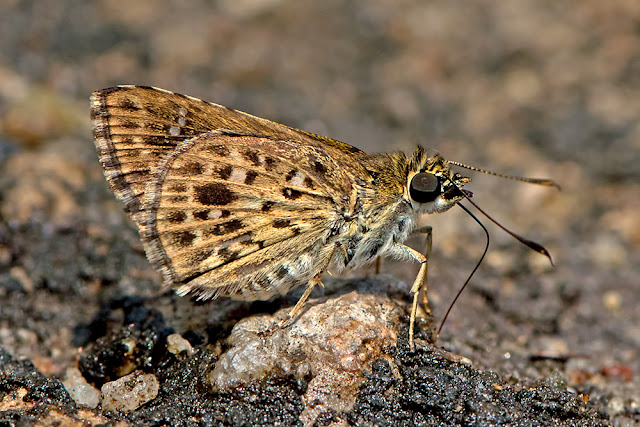 |
| Sovia albipecta, the Silver-breast Ace, puddling on an unknown substance near a mountain stream. |
Further Reading
Beck J, Mühlenberg E & Fiedler K (1999). Mud-puddling behavior in tropical butterflies: In search of proteins or minerals? Oecologia 119: 140-148.
Boggs CL & Dau B (2004). Resource specialization in puddling Lepidoptera. Environmental Entomology 33: 1020-1024.
Braby MF (1995). Reproductive seasonality in tropical satyrine butterflies: Strategies for the dry season. Ecological Entomology 20: 5-17.
Chandima F, Ravi C, Chinthaka W, & Prithiviraj F (2017). Puddling in Elephant Dung by Lepidopterans in Wasgamuwa, Sri Lanka. Gajah 46: 14-20.
Downes JA (1973). Lepidoptera feeding at puddle-margins, dung, and carrion. Journal of The Lepidopterist’s Society 27: 89-99.
Krenn HW (2008). Feeding behaviours of neotropical butterflies (Lepidoptera, Papilionoidea). Stapfia 80: 295-304.
Molleman F (2010). Puddling: From natural history to understanding how it affects fitness. Entomologia Experimentalis et Applicata 134: 107-113.
Ravenscraft A & Boggs CL (2016). Nutrient acquisition across a dietary shift: Fruit feeding butterflies crave amino acids, nectivores seek salt. Oecologia 181: 1-12.
Rima N, Meme A & Hossain MM (2016). Puddling of butterflies in Jahangirnagar University campus and the bank of Bangshi river, Savar, Bangladesh. Jahangirnagar University Journal of Biological Sciences 5: 57-70.
Sculley CE & Boggs CL (1996). Mating systems and sexual division of foraging effort affect puddling behaviour by butterflies. Ecological Entomology 21: 193-197.


